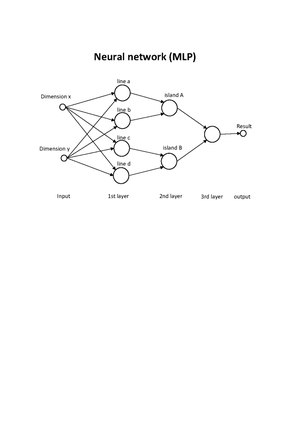Border pairs method


Border Pairs Method (BPM) is a machine learning algorithm for MLP.[1][2][3] BPM is suitable for classification tasks and has many advantages over its predecessor backpropagation:
- It is non iterative, it is done in one step/epoch.
- It eliminates useless learning patterns even before learning.
- It finds out how smooth learning patterns are even before learning.
- It is constructive, it finds the near optimal MLP construction (number of layers and neurons).
- It is not based on the gradient, it is without local minima, it is 100% reliable.
- It is suitable for noise removing.
- It is suitable for online and incremental learning.
Basic idea of BPM[edit]
During the learning of classification actually the position of the border line is determined. Original border line is usually nonlinear and is replaced here with linear sections. Each section is one LTU neuron in the first layer of MLP. Neurons in the second layer creates convex islands from sections that surrounds positive patterns. The third layer is the last one and executes logical OR operation with the islands from the second layer. With the usage of RTU neurons the second layer is no longer needed.
Example of learning with BPM[edit]
Figure 1 shows classification data with which MLP will be taught. 11 patterns from data are positive (red ones) and 13 are negative (blue ones). Only some of them are near border lines (7 red ones and 7 blue ones), other patterns are useless/barren. We draw sections of straight lines until all positive patterns are in homogenous islands. That is how we get island A (lines a and b) and island B (lines c and d). For each line we get one fully connected neuron in the first layer. In the second layer we make islands. For each of them a dedicated neuron is connected only with adequate neurons from the first layer. In the third layer logical operation OR is done with islands, because if pattern is from island A OR B then is positive (red). Figure 2 shows adequate MLP for data from figure 1. Dimension of input data is generally not limited to two, it could be arbitrarily big.
References[edit]
- ↑ Adaptive and intelligent systems : second international conference ; proceedings / ICAIS 2011, Klagenfurt, Austria, September 6 - 8, 2011. Springer Science+Business Media, 2011, ISBN 978-3-642-23856-7 Search this book on
 ..
..
- ↑ Border Pairs Method-constructive MLP learning classification algorithm. In: Neurocomputing. Volume 126, 27. Februar 2014, S. 180–187.
- ↑ Advances in Machine Learning Research In: Nova Science Publishers, ISBN 978-1-63321-214-5, July 2014.
External links[edit]
[1] BPM presetation on IBM Developers UnConference 2018, at IBM Research in Zurich
This article "Border pairs method" is from Wikipedia. The list of its authors can be seen in its historical and/or the page Edithistory:Border pairs method. Articles copied from Draft Namespace on Wikipedia could be seen on the Draft Namespace of Wikipedia and not main one.
